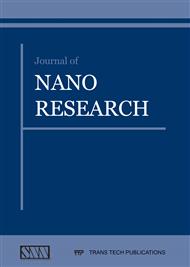p.148
p.154
p.165
p.179
p.192
p.203
p.212
p.225
p.234
Study on the Surface Damage Layer in Multiple Grinding of Quartz Glass by Molecular Dynamics Simulation
Abstract:
The paper focuses on the surface damage of quartz glass in multiple grinding, so as to find out the machining parameters that can improve the surface quality of quartz glass. Molecular dynamics (MD) method is adopted to machine the quartz glass. Firstly, the initial grinding is done on quartz glass with the depth of 12 Å. Based on the initial grinding, no feed grinding processes are done for three times separately and the feed grinding processes are carried out on the damage layer left by the previous process. By the coordination number (CN), machined surface topographies of quartz glass are gained and regions of densification are marked. Moreover, the damage layer thickness of different machined surface is also calculated. By analyzing the density of different surface damage layers, the regulation of the density distribution is obtained. Finally, the nanoindentation hardness is gained by different load-displacement curves in nanoindentation simulation. The results show that the first no feed grinding and the second feed grinding can improve the accuracy and quality of grinding. Too many no feed grinding processes and other feed grinding processes will induce serious damage of the machined surface, which is clearly showed in the obvious increase in the density, hardness and thickness of the damage layer. At last, the results of the density analysis and nanoindentation also proved that the densification and hardness of quartz glass cannot increase unlimited. The results can be applied in the ultra-precision grinding of quartz glass to control the thickness of damage layer and improve the quality of processing.
Info:
Periodical:
Pages:
192-202
Citation:
Online since:
March 2017
Authors:
Price:
Сopyright:
© 2017 Trans Tech Publications Ltd. All Rights Reserved
Share:
Citation:


